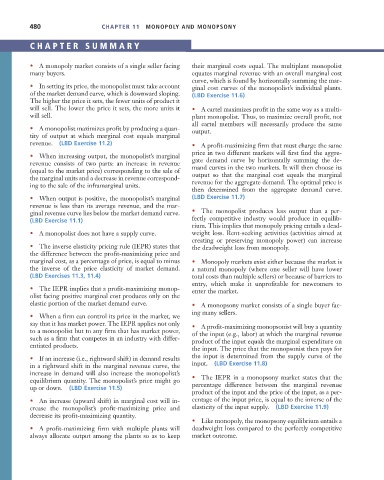Page 506 - Microeconomics, Fourth Edition
P. 506
c11monopolyandmonopsony.qxd 7/14/10 7:58 PM Page 480
480 CHAPTER 11 MONOPOLY AND MONOPSONY
CHAPTER SUMMAR Y
• A monopoly market consists of a single seller facing their marginal costs equal. The multiplant monopolist
many buyers. equates marginal revenue with an overall marginal cost
curve, which is found by horizontally summing the mar-
• In setting its price, the monopolist must take account ginal cost curves of the monopolist’s individual plants.
of the market demand curve, which is downward sloping. (LBD Exercise 11.6)
The higher the price it sets, the fewer units of product it
will sell. The lower the price it sets, the more units it • A cartel maximizes profit in the same way as a multi-
will sell. plant monopolist. Thus, to maximize overall profit, not
all cartel members will necessarily produce the same
• A monopolist maximizes profit by producing a quan- output.
tity of output at which marginal cost equals marginal
revenue. (LBD Exercise 11.2) • A profit-maximizing firm that must charge the same
price in two different markets will first find the aggre-
• When increasing output, the monopolist’s marginal
revenue consists of two parts: an increase in revenue gate demand curve by horizontally summing the de-
(equal to the market price) corresponding to the sale of mand curves in the two markets. It will then choose its
the marginal units and a decrease in revenue correspond- output so that the marginal cost equals the marginal
ing to the sale of the inframarginal units. revenue for the aggregate demand. The optimal price is
then determined from the aggregate demand curve.
• When output is positive, the monopolist’s marginal (LBD Exercise 11.7)
revenue is less than its average revenue, and the mar-
ginal revenue curve lies below the market demand curve. • The monopolist produces less output than a per-
(LBD Exercise 11.1) fectly competitive industry would produce in equilib-
rium. This implies that monopoly pricing entails a dead-
• A monopolist does not have a supply curve. weight loss. Rent-seeking activities (activities aimed at
creating or preserving monopoly power) can increase
• The inverse elasticity pricing rule (IEPR) states that the deadweight loss from monopoly.
the difference between the profit-maximizing price and
marginal cost, as a percentage of price, is equal to minus • Monopoly markets exist either because the market is
the inverse of the price elasticity of market demand. a natural monopoly (where one seller will have lower
(LBD Exercises 11.3, 11.4) total costs than multiple sellers) or because of barriers to
entry, which make it unprofitable for newcomers to
• The IEPR implies that a profit-maximizing monop- enter the market.
olist facing positive marginal cost produces only on the
elastic portion of the market demand curve. • A monopsony market consists of a single buyer fac-
ing many sellers.
• When a firm can control its price in the market, we
say that it has market power. The IEPR applies not only • A profit-maximizing monopsonist will buy a quantity
to a monopolist but to any firm that has market power, of the input (e.g., labor) at which the marginal revenue
such as a firm that competes in an industry with differ- product of the input equals the marginal expenditure on
entiated products.
the input. The price that the monopsonist then pays for
the input is determined from the supply curve of the
• If an increase (i.e., rightward shift) in demand results
in a rightward shift in the marginal revenue curve, the input. (LBD Exercise 11.8)
increase in demand will also increase the monopolist’s
equilibrium quantity. The monopolist’s price might go • The IEPR in a monopsony market states that the
up or down. (LBD Exercise 11.5) percentage difference between the marginal revenue
product of the input and the price of the input, as a per-
• An increase (upward shift) in marginal cost will in- centage of the input price, is equal to the inverse of the
crease the monopolist’s profit-maximizing price and elasticity of the input supply. (LBD Exercise 11.9)
decrease its profit-maximizing quantity.
• Like monopoly, the monopsony equilibrium entails a
• A profit-maximizing firm with multiple plants will deadweight loss compared to the perfectly competitive
always allocate output among the plants so as to keep market outcome.

